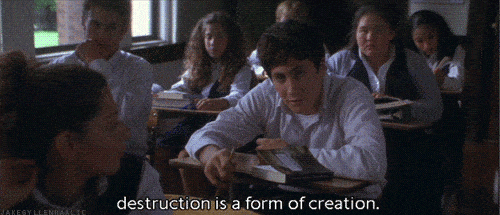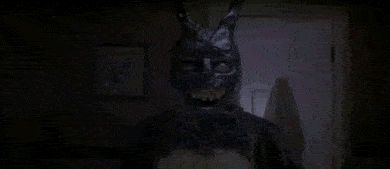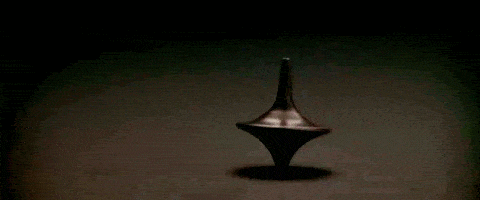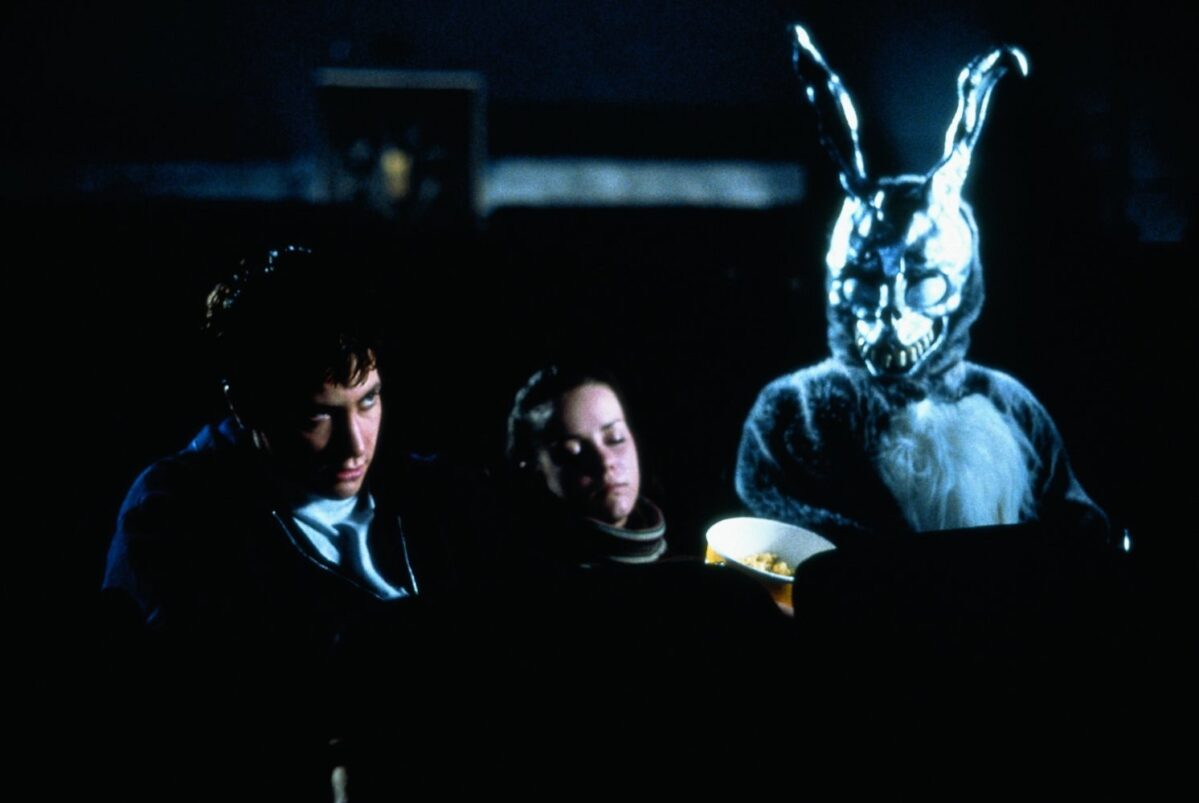I don’t think it will surprise anyone when I say that Donnie Darko is a weird movie.
The theatrical version can leave a viewer in complete and absolute befuddlement. Richard Kelly’s Director’s Cut wants to take it easy on the audience so throws in some exposition in the form of pages from Roberta Sparrow’s The Philosophy of Time Travel. These pages, when considered, explain most of the plot machinations of the film.
They explain that there’s a Primary Universe. But sometimes that universe is disrupted and thus we get a Tangent Universe. The Tangent Universe is unstable. If it’s not “corrected” in 28 days, then it collapses, creating a dimensional paradox that could destroy the Primary Universe.
99.99% of Donnie Darko takes place in this Tangent Universe. The main debate that most Donnie Darko uber-fans have is whether or not the very beginning of the movie, where Donnie wakes up on the mountain trail, is part of the TU or the PU. Other than that, the only part in the Primary Universe is the very end—from when Donnie’s laughing in bed and the airplane crushes him to the final frame of the movie.

So the shortest explanation of Donnie Darko‘s ending is this: Donnie was the hero chosen to correct the Tangent Universe and prevent the collapse of the Primary Universe. He’s able to do so. Then we have three basic ways to feel about what happens to Donnie. 1: He chooses to die by not leaving his bedroom even though he knows the plane engine is about to land there. 2: He’s suffered a complete psychotic break so can’t leave his bedroom even if he wanted to. 3: The Donnie in the Primary Universe was entirely unaware of what was about to happen and got crushed. There’s no clear answer, as far as I’m aware.
The plot mechanics are pretty simple. Which is why I want to spend this piece discussing some of the thematic meaning of the film that I haven’t really seen talked about. Specifically how Donnie Darko actually introduces a mechanical god and gets into Simulation Hypothesis and could cause you to view your entire life differently.
Let’s get this roller coaster started…
Deus ex machina in Donnie Darko
The Tangent Universe essentially is a virus, and the Primary Universe uses the people within the Tangent Universe as a kind of immune system. What this means is that everyone in the Tangent Universe is devoid of free-will. They are all acting in such a way as to guide the “Living Receiver” to fulfill his/her duty of “destroying the virus”. This means that everything that happens in Donnie Darko is part of bringing Donnie to the point where he can save the universe. It’s like a big cause-and-effect experiment.
This all comes back to the notion of deus ex machina. Defined as: an unexpected power or event saving a seemingly hopeless situation, especially as a contrived plot device in a play or novel.
The phrase is pointed out in the movie by Drew Barrymore: click here
In that discussion, Barrymore says that it’s deus ex machina that saves some rabbits: one rabbit has a vision and tells the rest that they’re in danger. Without the vision, all the rabbits would have died. Within the Tangent Universe, conversations like this aren’t just random.
What’s funny is that the movie straight up tells us: the rabbits are the characters in the movie. And the characters in the movie are the people of the Tangent Universe. They aren’t real people. They’re copies, manipulated by a power greater than themselves in order to correct an anomaly that threatens the health of the system as a whole. When they die, as several characters do: should we mourn them? From Donnie’s perspective, no, we shouldn’t. They’re not real people. But as Gretchen points out, the rabbits are a product of the author’s imagination, and we care for them because the author cares for them.
So on the one hand, Donnie Darko is the living embodiment of deus ex machina. He’s the contrived plot element that has unexpected power and saves the universe. But if we scale back, we remember that all the characters in the Tangent Universe are playing roles to guide Donnie to his destiny.
Barrymore doesn’t write “cellar door” on the chalkboard for no reason. It’s to prime Donnie for when he’s at Roberta Sparrow’s house and doesn’t know what to do. He then has the “ah-ha!” moment of realizing he has to go into the basement. Guess who’s there, for no apparent reason! The thugs that happen to hate Donnie! It’s just one plot contrivance after another. But these contrivances are arranged in such a way as to become a dance, a narrative choreography that brings a character to a moment of feeling such detachment with the world that they take an active role in that world’s destruction.
And yet if we scale back further, we see the movie actually features a “god from a machine”. This needs a little bit more backstory.
The history of deus ex machina:
Deus ex machina became popular as a term because so many plays in Ancient Greece involved a god arriving to save the day. The Greeks legitimately had a mechanical arm that brought the god onto the stage. Like…a crane and rope and a human being attached to this thing that would swing around. It’s impressive (but also a tad silly?). But because it was so common for the god to arrive to save the day, and because it was such a contrived and expected thing, the phrase stuck around far after the theater stopped having gods swooping in to save the day.
This applies to Donnie Darko in a weird way.
The god that is machine
You may have noticed that there are a few scenes where we see an eyeball and an increasing amount of information overlaid onto the eyeball. We eventually get different screens within the frame, like we’re looking at a bunch of TVs or computer monitors. (For a refresher, click here)
The obvious question here is “why?” And the simple solution is: god from the machine.
Remember at the end of the Barrymore scene with rabbits? Drew refers to deus ex machina as “The God Machine,” a simplified translation of deus ex machina. And we know from our brief history lesson that “deus ex machina” literally was the machine that brought gods.
But in Donnie Darko that concept is taken to it’s extreme: God is in the machine, or God is a machine. However you want to phrase it, there’s a mechanical element that combines with the omniscient element, to where god and machine are one. And this is what’s truly saving everyone and everything. Not Donnie, not the people manipulating Donnie, but the omniscient force manipulating the people and manipulating Donnie. With this in mind, we can view the Tangent Universe as a bug in the machine’s programming.
This is why the Director’s Cut includes these scenes that combine the eyeball, a traditional symbol for the soul, with the overlays of information and screens. What’s kind of cool and strange about this is that there’s an actual field of study in physics and philosophy called “simulation hypothesis”.
Simulation Hypothesis
Simulation Hypothesis is a field dedicated to understanding whether we are actually living in some simulation of the universe, rather than in the actual universe. On the one hand, that seems like the stupidest thing I’ve ever heard. On the other hand, a bunch of really smart physicists and philosophers think that it might actually be true.
Read all about it: here.
Donnie Darko brings in elements of the Simulation Hypothesis to shape the universe the story takes place in. In this world, there is a God Machine and reality is a simulation.

If we zoom out from there, what we see is that life is nothing more than a story. The God Machine is, as Barrymore says, the miracle of storytelling. God is the force that contrives the story, the universe is a story, and we’re all playing our roles in that story. And while our individual dramas matter to us, there’s a much larger drama unfolding that each of us is a part of.
That makes the conversation between Donnie, Gretchen, and Barrymore all the more important. Donnie sees no reason to pity “the others”. He embodies selfishness. Where Gretchen is the opposite to that. She pushes an agenda of valuing the characters, even if they’re characters, because the author cared about them. Thus, she embodies compassion. But Barrymore admires the story itself, the god machine, that larger force that saves the rabbits. She embodies spirituality.
Viewers will end up split between those three archetypes.
Are you Donnie, Gretchen, or Barrymore
As a viewer of Donnie Darko you may feel like Donnie and not care about the characters or what happened, since it’s just a movie and not real people. Others will feel like Gretchen and care about the characters and the emotion of the story. While others still will be like Barrymore and care more about the miracle of storytelling: what’s being said, how it’s being said, why it’s being said.
Inception and cruelty and the miracle of story

What’s crazy is that Donnie Darko is sort of Inception before Inception was ever a thing. The Tangent Universe is a world-within-a-world. In the Tangent Universe, Donnie completes his job of sending “the artifact” (the airplane engine) through a portal from the TU to the PU. With the glitch fixed, the Tangent Universe collapses. Which is what we see with the eye and the machine code and the screens (one even flashes “Purge”). We then arrive at the Primary Universe.
The characters in the Primary Universe all realize something has happened. The same way in Inception that the “incepted” have the faint memories of their dream but nothing more tangible. The dream disappears and they go on with their life, though influenced in a way they can’t quite explain. We see many of the Donnie Darko characters “waking up” on October 2nd, haunted by what was, to each of them, a private and unique dream.
We see this dynamic at play in how Gretchen doesn’t know Donnie’s name but feels a strange compulsion to wave to Donnie’s mom. All at once, Gretchen and the mom have no idea why they’re waving to each other, why they feel a connection at the moment, but they feel it, they recognize that something is shared between them.
What’s beautiful is that this ties back to the conversation about the rabbits and the miracle of story. All of the movie characters are characters in a story. But the story-within-a-story design means that the characters we saw aren’t really the “real” characters. The Gretchen we got to know isn’t the real Gretchen. The Donnie we got to know isn’t the real Donnie. The Drew Barrymore we got to know isn’t the real Drew Barrymore. The Dr. Ross from ER that taught science isn’t the real Dr. Ross from ER that taught science. All of those were tangents of the real people.
This seems particularly cruel. Because we already know that movie characters aren’t real. Like, people love Harry Potter and Batman. Even though we know Harry Potter isn’t real and that Batman isn’t real. But we suspend disbelief and like to pretend the characters exist in their own universes. That in the universe of Harry Potter, Harry and Hermione and Ron really lived the lives that we see in the books/movies. This is the wonderful illusion of story, this is, as Drew Barrymore’s character says, the miracle of story.
Yet Donnie Darko goes the extra step to say, “Not only are the characters in this movie not real, the ones you just spent two hours learning about and caring about don’t even actually exist in the world of the movie. You don’t know who these people really are.” Would Gretchen have dated Donnie? Jim Cunningham may not have even been a pedophile. In fact, maybe Donnie wasn’t who we saw in the Tangent Universe—an emotionally up and down anti-hero who’s flawed but ultimately endearing and well-meaning. Maybe he was far closer to the maniac we see at the end of the movie, laughing hysterically for no observable reason.
Tell me about the rabbits
That begs the question: do we care about the rabbits? If we know know that Primary Universe Gretchen is alive…does that mean we shouldn’t mourn the death of Tangent Universe Gretchen? If we know Tangent Universe Donnie is nothing like Primary Universe Donnie…do we even care that Primary Universe Donnie died?
We can even extrapolate this to our reality. A friend will call us and tell us about something that happened to someone we went to high school with. How true is that story? Does your friend know all the facts? The story that your friend tells you could very well be a Tangent Universe, so to speak. Some of it may be true, but not all of it. All the time, we let stories and second hand information shape how we think of someone. We create versions of these people based on the scraps of information we collect overtime. We have ideas of how they live their lives. Of the kinds of houses they live in. The friends they have. How they spend their time. We create entire tangent realities for them. And maybe that matches up pretty well with the actual reality. But oftentimes, it’s not what we expected. They have a much nicer house than you thought. They have a much worse house than you thought. They are a better parent. They are a worse parent. They wear clothes you’d never expect. etc. etc.
How do these Tangent Universes affect how we perceive people? Even scarier, what Tangent versions of yourself are other people creating?
So even if Donnie Darko‘s plot ends up being kind of straightforward, the implications of story, the themes of the story, are pretty complex and huge.

